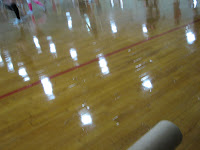 What you see is what you get...not really! Be sensitive to how we present visual information to our students. Sometimes we don't "see" what another person might be noticing. For instance, I was with a youngster in the computer lab. This little girl was making faces at the computer but not attending to what was on the screen. I realized there was a strong reflection from the lights above. Even though I was looking "beyond" the reflection to notice the important information on the screen, the student was using the computer screen as a mirror!
What you see is what you get...not really! Be sensitive to how we present visual information to our students. Sometimes we don't "see" what another person might be noticing. For instance, I was with a youngster in the computer lab. This little girl was making faces at the computer but not attending to what was on the screen. I realized there was a strong reflection from the lights above. Even though I was looking "beyond" the reflection to notice the important information on the screen, the student was using the computer screen as a mirror!Think about how we laminate materials. Is the glare from the surface going to affect what the child sees? If so, use contact paper if you need to protect the materials.
Have you guessed what the image is above? Is it a glossy gym floor at my niece's volleyball tournament. You can imagine how a particular child might focus on the lights instead of the action, making it difficult to discriminate the relevant information from the background.
Students on the autism spectrum often have trouble making sense of our visual world. They might be focusing in on visual details and patterns rather than the "whole picture". An unfamiliar environment might cause an individual to go into sensory overload. Difficult behaviors could result from trying to shut out the onslaught of meaningless sensations. A wonderful description of this is from the book, The Curious Incident of the Dog in the Night-time, by Mark Haddon. Check it out.
No comments:
Post a Comment